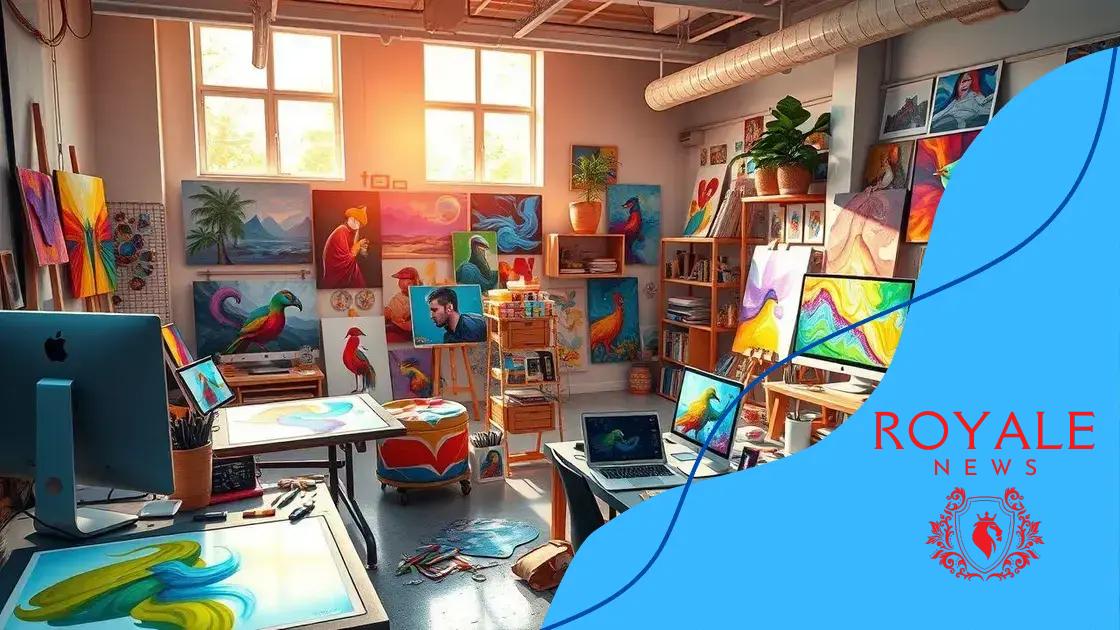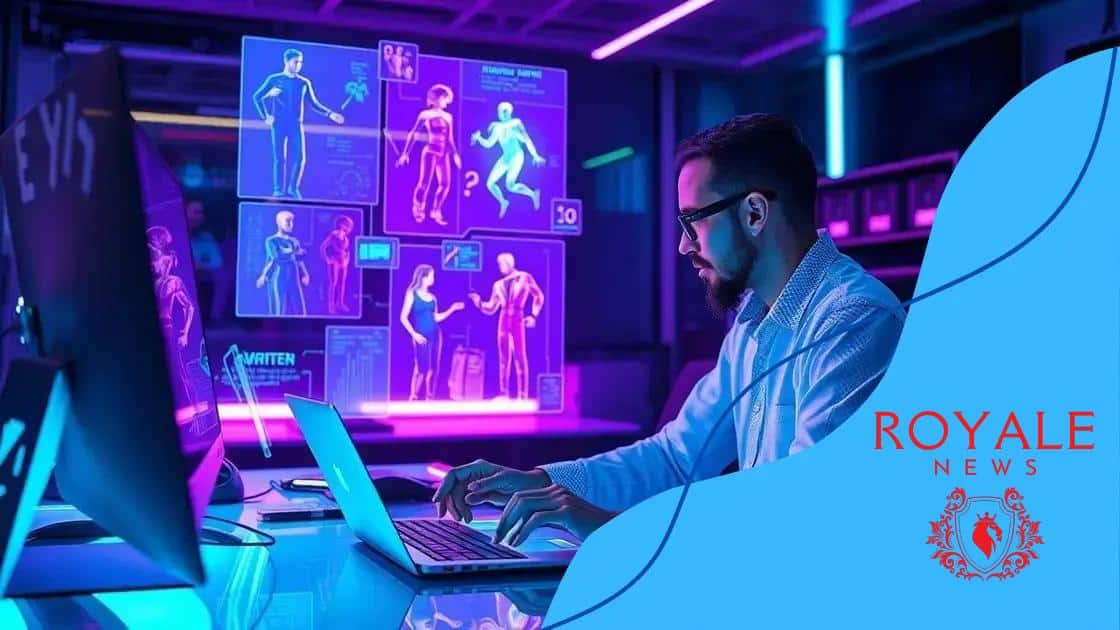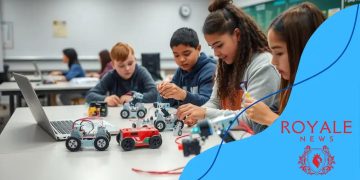The role of AI in transforming the creative industries

The role of AI in transforming the creative industries enhances creativity, improves productivity, and democratizes access to art, while presenting challenges related to job security and maintaining authentic artistic expression.
The role of AI in transforming the creative industries is more significant than ever, influencing how artists work and engage with audiences. Have you noticed how technology is reshaping creative expression? Let’s dive into this exciting transformation.
How AI enhances creativity in art and design
AI enhances creativity in art and design by providing tools that allow artists to explore new ideas more easily. This technology opens up a world of possibilities that were once unimaginable. Artists can use AI to generate inspiration and assist in the creative process.
How AI Tools Affect Creativity
Many artists are now using AI tools to push the boundaries of their creativity. Programs that utilize machine learning can analyze vast amounts of data, offering unique insights and suggestions that artists may not have considered.
Benefits of AI in Design
- Increased efficiency in creating artwork.
- Opportunities for collaboration with AI systems.
- Ability to experiment with different styles quickly.
- Enhanced data-driven design decisions.
AI can also help in improving the consistency of designs by providing templates and suggestions that fit the artist’s style. This way, creative professionals can focus more on their ideas rather than repetitive tasks. As AI-generated art gains popularity, it encourages artists to blend traditional methods with innovative technology.
Furthermore, AI can aid in identifying trends in the artistic community. By analyzing social media and online platforms, AI tools can reveal what kinds of designs resonate with audiences. This immediate feedback allows artists to adjust their work to better appeal to their target market.
While embracing AI, it’s essential for artists to maintain their unique voices. The goal is not to let AI replace human creativity, but to enhance it. Artists can leverage AI as a partner in their creative journey, opening doors for new artistic expressions.
The impact of AI on music production and composition
The impact of AI on music production and composition is profound, changing how we create, produce, and listen to music. By harnessing advanced algorithms, musicians can now explore new sounds and structures that were once unimaginable.
Revolutionizing Music Creation
AI is helping artists in the composition process by generating melodies, harmonies, and even entire songs. This technology can analyze existing music to develop unique compositional styles. Musicians can feed AI systems with specific criteria, allowing them to experiment with various musical elements without facing creative blocks.
Efficiency in Production
- AI tools streamline the mixing and mastering process.
- Real-time feedback from AI assists artists in making quick adjustments.
- Automatic arrangement suggestions help fill out a track.
- Data analysis reveals which genres are trending.
Moreover, AI can enhance collaboration between musicians and producers. Virtual assistants can help schedule recording sessions or manage project timelines, leading to more efficient workflows. The synergy between human creativity and AI mechanics creates a powerful combination.
Another key area is how AI influences music marketing. By utilizing algorithms to analyze listener preferences, artists can craft tailored promotional strategies. They can identify potential audiences that align with their music style. This shifts how marketing connects artists to listeners, making the experience more personalized than ever.
Undoubtedly, the rise of AI in music has raised questions about authenticity and creativity. While some argue that music generated by AI lacks the emotional depth of human creation, many artists embrace it as a tool to expand their creative horizons. As technology advances, the collaboration between human artists and AI will continue to shape the future of music.
AI-driven storytelling: how it changes narratives

AI-driven storytelling is revolutionizing how we create and consume narratives. These advancements enable writers and filmmakers to develop stories in innovative ways that captivate audiences like never before.
The Role of AI in Story Development
AI tools are now available to aid in crafting plots, creating characters, and developing dialogue. By analyzing successful narratives, AI can suggest elements that resonate with viewers or readers. This not only enhances the creative process but also saves time.
Dynamic Narrative Creation
- AI can generate multiple plot twists based on audience feedback.
- Interactive storytelling creates personalized experiences.
- AI algorithms can adapt narratives in real-time.
- Data insights shape content tailored to different demographics.
Moreover, AI-driven storytelling allows for greater interactivity. For example, in video games and virtual reality, AI can create adaptive narratives that respond to players’ choices. This kind of engagement leads to immersive experiences where every decision shapes the outcome.
As AI continues to learn from vast amounts of data, it becomes more adept at understanding what audiences find engaging. This ability helps writers push the boundaries of traditional storytelling. By leveraging AI, creators can combine their unique visions with cutting-edge technology, resulting in stories that are fresh and exciting.
Despite these benefits, some writers express concerns about losing creative control. The key is using AI as a tool rather than a replacement. A partnership where human intuition and AI’s analytical strength work together can lead to the best of both worlds. This collaboration fosters creativity and opens new doors in storytelling.
Challenges faced by creative professionals in the AI era
Creative professionals face numerous challenges in the AI era. As artificial intelligence becomes integral to various creative fields, understanding how it impacts jobs, creativity, and industry standards is essential.
Job Security and Automation
One of the most significant concerns is job security. AI can automate many tasks traditionally handled by humans, leading to anxieties over job loss. For instance, automated editing software can enhance images or videos in a fraction of the time it takes a professional. This raises questions about the future role of human creatives in industries like graphic design and video production.
Maintaining Authenticity
- Striking a balance between AI-generated content and human creativity.
- Ensuring that art retains its emotional resonance.
- Addressing the perceived value of human-made vs. AI-made work.
- Upholding personal style in a landscape dominated by algorithms.
Another challenge is maintaining authenticity. Artists worry that reliance on AI could dilute their personal touch in their work. When algorithms drive creative decisions, the uniqueness of artistic expression may suffer. Striking a balance between AI assistance and personal creativity is crucial for preserving the emotional depth of art.
Additionally, the speed at which AI evolves poses challenges for professionals. Keeping up with new technologies and integrating them into their workflows requires continuous learning. This can be overwhelming, as practitioners must adapt and innovate constantly while ensuring their skills remain relevant.
Last, ethical concerns about content ownership and originality arise. When AI generates art or music, questions emerge about who owns the rights to that work. These legal and ethical dilemmas complicate the relationship between technology and creativity, demanding clear guidelines and discussions within the industry.
The future of the creative industries with AI technology
The future of the creative industries looks promising with AI technology at the forefront. As AI tools continue to evolve, they will shape how artists, musicians, and designers work and innovate.
Emerging Trends in the Creative Sector
One significant trend is the integration of AI in the creative process. Artists are collaborating with AI to produce work that combines human creativity with algorithmic efficiency. This partnership allows for greater experimentation, leading to unique artistic expressions that push boundaries.
Benefits of AI in Creative Work
- Increased productivity and efficiency in production.
- Access to advanced tools that enhance creativity.
- Personalized content creation tailored to audience preferences.
- Greater collaboration opportunities across different media.
As we look to the future, the potential for personalized content grows. AI can analyze audience behavior and preferences, allowing creators to develop tailored experiences that resonate deeply with their target demographics. This approach not only enhances viewer engagement but also increases satisfaction.
The implementation of AI also democratizes creativity. Individuals without extensive training can leverage these technologies to create high-quality work. With intuitive AI tools, anyone can explore their creative ideas, leading to a more diverse range of voices and expressions in the industry.
Furthermore, the rise of immersive experiences, such as virtual reality and augmented reality, will shape the landscape of storytelling and art. AI will play a crucial role in developing these environments, creating deeper connections between audiences and creators. As technology advances, the creative industries will expand, offering new platforms for artistic expression.
FAQ – Frequently Asked Questions about AI in Creative Industries
How does AI enhance creativity in art and design?
AI provides tools that assist artists in generating unique ideas, optimizing their creative process, and exploring new styles.
What challenges do creative professionals face with AI technology?
Challenges include job security concerns, maintaining authenticity in their work, and keeping up with the fast pace of technological advancements.
Can AI help in personalized content creation?
Yes, AI analyzes audience preferences to create tailored experiences, ensuring the content resonates with specific demographics.
What is the future of storytelling with AI?
The future of storytelling involves dynamic narratives that adapt based on audience interactions, providing more engaging and immersive experiences.





